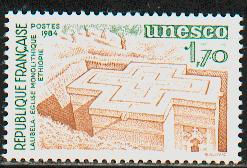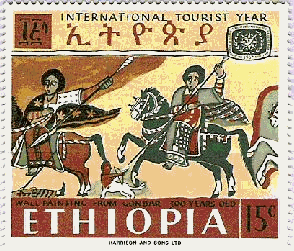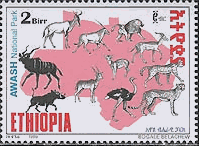


Located in the arid north, near where the great famine of 1984-85 took place, are the subterranean churches of Lalibela, built 800 years ago. Some are sculpted out of solid volcanic rock. Others are connected by long underground tunnels and mazes. Some are quarried enlargements of caves. The maze of churches offers a tremendous variety of styles: Grecian pillars, Arabesque windows, ancient swastika and Star of David carvings, arches, and Egyptian-like buildings. The main cluster of 10 churches are located in the village center -- Bet Golgotha, Bet Mia'el, Bet Maryam, Betk Meskel, Bet Danaghel, Betmedhane Alem, Bet Amanuel, Bet Merkorios, Bet Abba Libanos, and Bet Gabriel-Rufa'el.
Legend has it that Lalibela was built by angels armed with masonry tools. No one knows the true story of how these churches came to be. Archaeologists say it would have required the work of 40,000 men to carve the labyrinths of grottoes, courtyards, caverns, and walls out of the mauve-colored rock. The locals have maintained over centuries that the man responsible was King Lalibela who lived from 1181 to 1221. According to legend, angels carried Lalibela to heaven while he was under the influence of a sleeping potion administered by his jealous brother, Harbay. God told Lalibela to return to earth and construct unique churches. He did just that, and angels worked through the night to speed up the process.
The park is home to some extremely rare animals such as the Gelada baboon, the Simien fox and the Walia ibex, a goat found nowhere else in the world.

The fortress-city of Fasil Ghebbi was the residence of the Ethiopian emperor Fasilides and his successors in the 16th and 17th centuries.
Axum is the legendary birthplace of the Queen of Sheba, which allegedly houses the Ark of Convenent.

The oldest remains found at the site date back at least 4 million years and provide evidence of human evolution which has modified our conception of the history of humankind. The most spectacular discovery came in 1974, when 52 fragments of a skeleton enabled the famous Lucy to be reconstructed.
The discovery of many fossils in this valley, especially Homo gracilis, has been of fundamental importance in the study of human evolution.
The site contains 36 monuments, including 32 carved stelae covered with symbols, most of which are difficult to decipher. They are the remains of an ancient Ethiopian culture whose age has not yet been precisely determined.
Paleontological Sites in the Highland Area of Ethiopia
Last updated: July 27, 2024